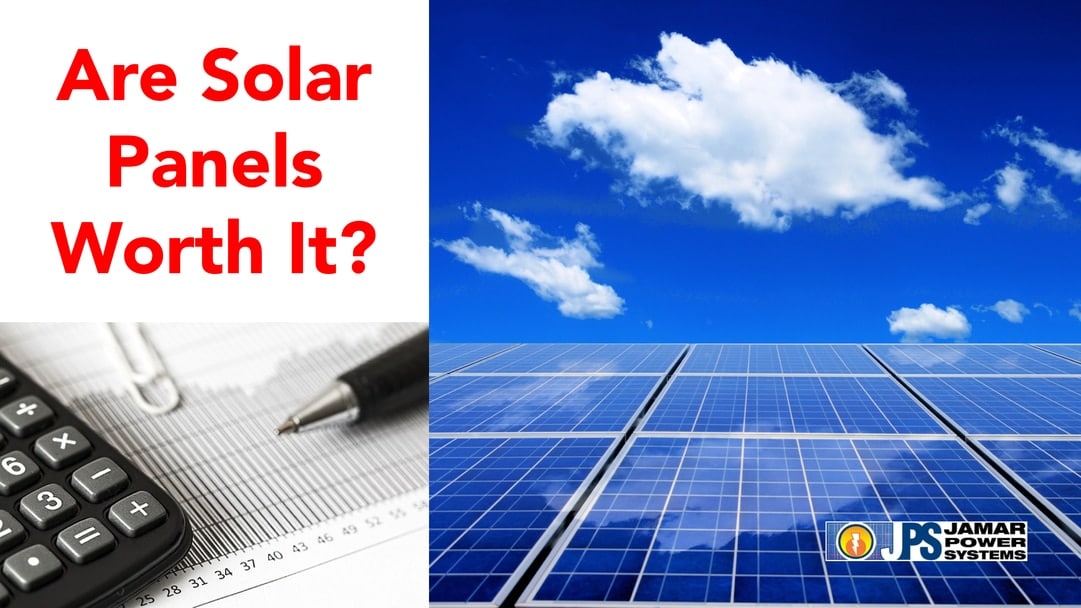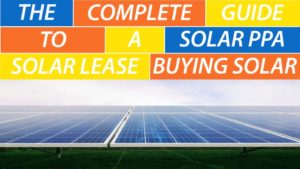Are solar panels worth it?
Are you thinking about installing solar panels? Many people wonder if they can afford it, if the panels produce enough energy, and if they’ll save money on their electric bills. If you’ve found yourself wondering whether solar panels are worth it—read on!
Electric utility bills are most homeowners’ largest monthly bill after the mortgage and car payments.
Here, we take a look at the cost of electricity, compare the price of solar power versus utility electricity, and find out how long it takes for solar panels to pay for themselves.
We’ll also look at energy security from utility blackouts, affects on real state values, and environmental benefits to see if solar panels are worth it for most homeowners.
First, let’s take examine where you’re buying your electricity from now.
How much is electricity from the electric company?
Your current supplier is the electric utility company, which is SDG&E for most people here in San Diego County.
The 2022 Total Electric Rate Schedule from SDG&E has three usage tiers which are:
- 34.2 cents per kilowatt-hour ($/kWh) for up to 130% of baseline kWh.
- 43.0 cents per kilowatt-hour ($/kWh) for up to 131% to 400% of baseline kWh.
- 43.0 cents per kilowatt-hour ($/kWh) above 400% of baseline kWh.
The more electricity you use, the more you’ll pay for it. These are summer rates, whereas winter rates are about 10 percent less for each tier.
The average size household uses around 1,000 kilowatt-hours per month, more in the summer in Inland County areas, and a little less in the Winter months.
Let’s do the math and compare it to solar!
1,000 kilowatt-hours (avg. usage) x $0.342 per kWh (SDG&E tier 1 rate) = $342 per month electric utility company bill for the average San Diego household.
The electric company’s rates usually go up between 3 to 10% every year.
The electric utility company has a monopoly.
You will pay them for the rest of your life as long as you’re connected to their electric grid.
Until about twenty years ago, there was no alternative to the electric utility company. And then, solar power systems became affordable, and solar financing was made available, and homeowners began to have choices and the potential for significant savings.
Today, you have Solar Power options.
In most cases, when you’re looking into going solar, you’re looking to eliminate as much of the electricity you buy from the electric company as possible. A 100 percent offset is the goal.
Your specific electric usage, available space for solar panels, and several other factors will decide how large a solar energy system you need (see our article on “How many solar panels do I need?” for more information). How big a system you have room for is often a different story.
Most solar power systems are grid-tied, meaning your home is still connected to the electric utility company through their meter. During the day, you’ll be sending the utility company any excess energy that your system is producing.
You’ll receive net energy metering (NEM) credits for the energy you send the utility company and then use those credits at night when the solar power system is not generating electricity, and you’re consuming electric company power (check that your utility company provides NEM credits).
A 100 percent offset solar power system will result in you paying nothing for electricity from SDG&E at the end of every 12 months, what’s commonly called a Net-Zero home.
Note that solar customers still have a monthly bill from SDG&E to be connected to their utility, and receive Net Energy Metering credits for the electricity you send to them, and be able to use those credits and their energy at night. The minimum bill amount is currently $10/month as of this writing.
It’s common for your available roof space or other factors to prevent a 100 percent offset of your electric bill. As long as you can offset 50 percent or more of your electric usage, the math usually works out in your favor. Only a real solar analysis can find out.
With that said, since we’ve completed over 10,000 solar sales and installations, we can give you some good ballpark figures.
How much does solar energy cost?
Solar electricity rates in 2022:
- 6 to 8 cents per kilowatt-hour (kWh) if paying cash for the system.
- 10 to 15 cents per kilowatt-hour (kWh) if financing through a bank or solar loan.
- 10 to 18 cents per kilowatt-hour (kWh) if financing through a solar lease or power purchase agreement (PPA).
1,000 kilowatt-hours (average household use per month) x $0.13 average financed kWh of solar energy = $130 per month solar electricity cost for the average household.
The electric company bill for the same energy was $342 per month.
That’s a savings of $212 per month for solar power versus the SDG&E electric rates!*
No more paying for electricity for life!
Solar energy systems are either paid for either in cash, or more commonly through financing until it’s paid off.
All of the electricity the system produces after that is FREE forever (if you purchased instead of leased).
It’s like receiving a “Get out of Jail FREE card!” Instead of serving a life sentence with the utility company, your future solar power can be free.
Do you really save money with solar panels?
As you can see by the example shown above, solar electricity can cost less than half of current utility company rates, depending on how you finance it.
Even when using a zero-money-down solar loan, it’s common to save money beginning in the very first month your solar power system is turned on. Your total electric bill would be less each month than what you’re already paying.
If you’re paying cash, payback is fast, and then you’ve eliminated one of your most significant monthly bills for decades.
After ten years, solar energy systems regularly produce double-digit annualized returns on investment (ROI). See the example below.
Disclaimer: Savings are not guaranteed. Perform your due diligence and consult your advisors to make sure that solar is right for you.
Maintenance for solar panels and inverters are simply to keep them clean of dirt and debris and free from shade. See our solar maintenance guide for more info on caring for your solar panels.
How long will it take for solar panels to pay for themselves?
Solar panels pay for themselves surprisingly fast, and quality modules will provide free electricity for decades after that. Let’s take a closer look.
Solar panels are rated in Watts.
A premium, high-efficiency 350-Watt solar panel (module) costs around $1,000 installed (we’re a little on the high-side here to be conservative).
There’s a 26 percent federal income tax credit if the system is installed by December 31, 2022, which gets deducted and leaves an average net cost of $740 per solar panel.
Depending on many factors, including which compass direction the solar panels are facing (south to west is best), the average quality module will produce about 1.6 kilowatt-hours (kWh) each year for every rated Watt here in San Diego.
As such, a 350-watt premium solar panel multiplied by 1.6 equals 560 kilowatt-hours (kWh) produced by each solar panel each year.
So, a premium 350-watt solar panel with a net cost of $740 will produce about 560 kilowatt-hours (kWh) of electricity every year, which equals a price of 13.2 cents per kWh.
Tier one electric rates with SDG&E are 34.2 cents per kWh.
Solar produces each kWh at around 13.2 cents (very conservative example).
That’s a savings of 21 cents per kWh over the SDG&E electric rate!
Next, let’s multiply our $0.210 savings per kWh by the number of kWh each solar panel produces (560), and we get a very conservative cost of electricity savings of $117.60 per solar panel per year.
The net cost of the solar panel in our example is $740, divided by the $117 savings, which provides a payback of 6.3 years.
Every kWh produced after that is free and clear! And quality solar panels are warrantied for 25 years and designed to last 40 or more!
Once payback is achieved, each solar panel is then providing $191 per year of free electricity at today’s SDG&E tier 1 summer rates.
That’s a 258 percent Return on Investment! $191/yr savings x 10 years = $1,910 savings divided by $740 investment x 100 = 258 percent total 10-year return on investment. Annualized that’s 25.9% return per year.*
The returns are even greater if you’re using higher-priced tier 2 and 3 electricity from SDG&E.*
*This is an example only. Your exact savings and ROI may be higher or lower, depending on many variables. But as you can see, solar power often produces energetic returns on investment.
Uncle Sam Chips In With Solar Tax Credits (for a limited time)
To promote clean energy, the federal government offers an income tax credit equal to 26 percent of the total installed cost of the solar power system if installed by Dec. 31, 2022.
After Dec. 31, 2022, the federal solar investment tax credit (ITC) reduces to 22% for systems installed by Dec. 31, 2023.
In 2024 the ITC is eliminated to zero for residential installations and to ten percent indefinitely for businesses.
Unless for some reason you want to pay 26 percent more, you need to have your solar energy system installed and operating before December 31, 2022.
Electricity Rate Inflation Protection
Solar energy systems provide you with protection from the rising costs of utility company electricity.
For every kilowatt-hour you don’t buy from the utility company, you are saving it from decades of future rate increases. That savings can add up to tens of thousands of dollars over time.
Solar Provides Energy Security (no more blackouts!)
You gain energy security by reducing how much energy you buy from the utility company that would be subject to payments forever and future rate increases.
Additional energy security is obtained by removing your exposure to electric utility blackouts.
Whole house battery storage systems can nearly eliminate the threat of power outages. Solar power with a smart inverter and battery backup system can store the excess energy produced during the day instead of sending it to the utility company.
You would then use the battery power at night first, before using any utility company electricity (if at all needed).
In the case of a utility company blackout, your property would still have the available battery and solar power for use.
You can also design a solar with a battery backup system to work without being connected to the electric utility grid.
Note: properties with standard grid-tied solar power systems without batteries will lose all power if there is a utility company blackout. Utility companies cannot have solar electricity sent into a grid they need to repair and the inverters used are not designed to disconnect from the utility grid and operate independently as battery backup “smart inverters” and controllers are.
Conversely, solar energy systems with a smart inverter and battery backup system can work even when there’s a utility company blackout.
With planned electric blackouts becoming a common occurrence in California due to wildfires, having a battery backup system makes more sense than ever for many families and businesses.
If you have critical electric loads that can’t be shut down, or if you want to “Own Your Power” and not fall victim to electric utility blackouts, then a solar energy system with battery backup may be the solution for you.
Solar Can Power Real Estate Values
According to the U.S. Dept. of Energy, “Solar Homes Sell for a Premium.”
Look around, and you’ll see solar panels on more and more roofs in California. That’s because electric utility company rates are high, and we have lots of sunshine. It’s a perfect combination that motivates homeowners to look for alternatives and switch to solar to save money.
In January of 2020, all new homes built in California must have enough solar panels built in to provide all the home’s power, a Net-Zero Home.
Most homes with solar power have meager electric utility bills. That keeps their monthly operating expenses low, and that’s an attractive benefit to homebuyers.
More and more, when we sell our California homes, we’ll be competing with homes that have solar energy.
Be aware that solar leases and power purchase agreements can make selling a home more difficult because the new homebuyer will have to qualify to take over that financing or pay it off completely. This qualifying process has proven to disrupt and end many escrows.
Owning your solar power system gives YOU the power. You can add the value of the system to the sale price of the property — you have control, there’s no extra qualifying for anyone.
See our “Complete Guide to Solar lease, PPA, vs purchase,” for more info.
Solar Power Is Clean Energy
Solar energy is the most abundant source of energy in our known universe.
The Sun provides both heat and light. The heat can be used for heating a home, pool, or spa, and the light can be converted into electricity to power your home or business.
Enough solar energy hits the earth each day to power the entire planet’s current electric consumption for a whole year.
Solar energy is non-polluting. The only environmental impacts are from the collection of the materials and manufacture of the parts of the products.
1 kWh of utility company electricity produces about 1.106 pounds of carbon dioxide (CO2) pollution.
A 30-year-old tree absorbs about 193 pounds of CO2 per year.
A sample size solar power system of 7500 Watts would prevent the producing of 9,606 pounds of CO2. That’s the equivalent work of about 50 thirty-year-old trees.
Source: Tree Math 2 by New England Clean Energy
Do NOT Buy Only On Price
Like all things, some companies manufacture good quality solar products, and others make cheap, poor-quality, low-cost products.
The problem with low-cost solar products are that they’re exposed to the weather every minute of every day and need to last for decades to power your home or business.
Roof weather is crazy. When it’s 90 degrees outside, it’s well over 200 degrees on your tile roof!
Heat, freezing cold, rain, dry, snow, sleet, and hail. The weather is going to destroy all low-quality solar panels and inverters.
Only quality products made with high-quality materials will survive the weather for decades and produce reliable energy for your home.
The solar industry has been booming for over a decade now. In that time, over 100 solar panel and inverter manufacturers have come and gone. Bankrupt and with little or nothing left to support the warranties of their products
If the manufacturer of your solar panels or inverters won’t be around to warranty their products, you might have a financial disaster on your hand. Especially if they didn’t manufacture quality products.
Price is always an issue when buying anything, but when comparing solar energy systems, it should not be the primary driving force behind your decision.
Be sure you are comparing high-efficiency products with comparable high-efficiency products. Apples to apples.
Have your investment advisor look at the financials of the manufacturers the solar installers recommend to you. Google them and do some research.
Choosing a solar energy system based on price alone stands a higher likelihood of costing you the most over time (in repairs and lost electricity you now have to buy from the utility again).
For more information and guidance selecting a solar company, see our article, “How to Choose a Solar Installer.”
Conclusion
Ultimately, solar panels are worth it in several ways for most homeowners. Solar energy provides an excellent financial investment opportunity. Regardless of whether you’re motivated by saving money, energy security, or reducing carbon emissions, solar panel systems can generate significant savings.
Over the course of 20 years, potential savings from using solar panels can be tens of thousands of dollars for the average home. Disclaimer: savings are not guaranteed. Each situation is different.
If you live in the San Diego area, or any place where the electric utility rates are high, solar power for your home is an investment that may offer you superior returns.
Save money on your current and future energy costs and reduce your carbon footprint by going solar today!
Get a FREE Solar Analysis for your home!
Use our free San Diego solar calculator to get a ballpark figure on how much a solar energy system for your home would cost and what a financing payment would be.
- 2025 Federal Tax Credit Changes For Solar Panel Systems & Solar Batteries - July 8, 2025
- How Solar Batteries Work - March 4, 2024
- Solar Battery or Generator for Emergency Backup Power? - January 30, 2024



